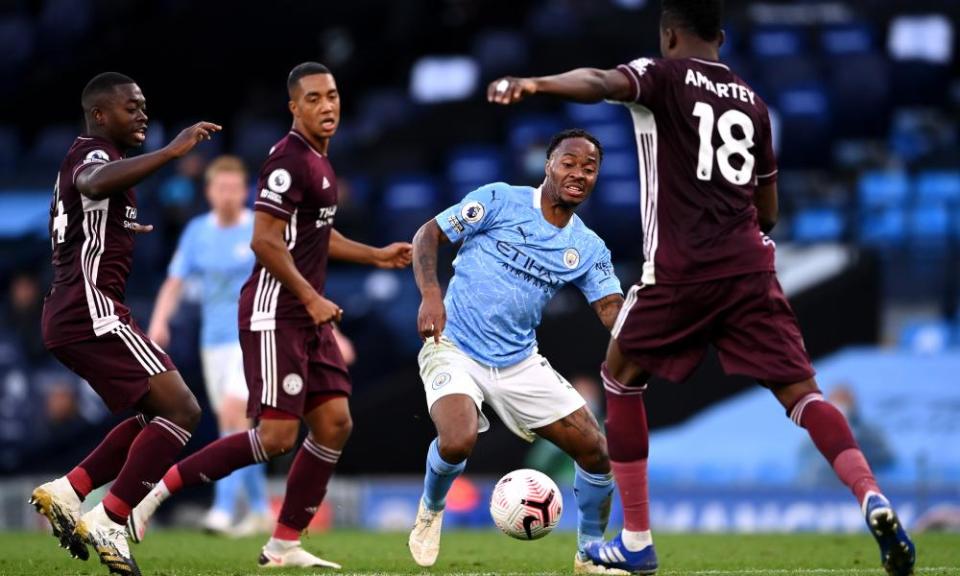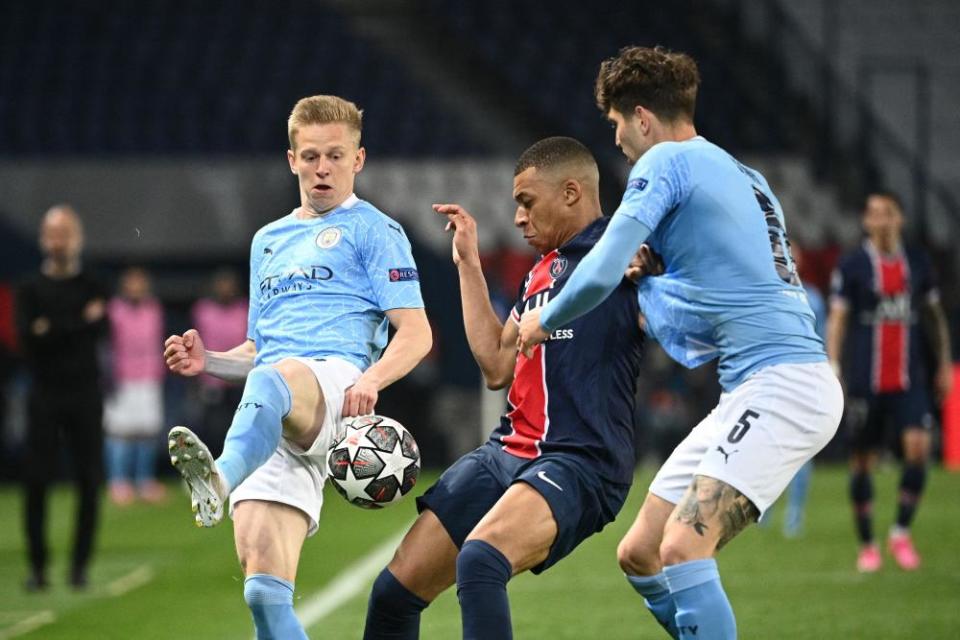Pep Guardiola has mixed possession and pressing to start new Manchester City era

The Premier League title was confirmed for Manchester City on Tuesday, having never been in doubt since March. A run of 15 straight victories from mid-December. A team that, in rhythm, is mesmerisingly good. A squad able to withstand the rigours of a season even more relentless than usual.
It would be easy from the perspective of late spring, as the tides of Covid recede – in the UK at least – to think City’s triumph was just another super-club victory. But what makes it significant is how different everything looked three months into the season. It would be absurd to suggest their resources haven’t helped, but this was a title that was far from inevitable.
Related: ‘Imperious campaign’ – player ratings for Manchester City’s title winners
When City drew at home against West Brom on 15 December, they lay sixth in the table having won five of their first 12 games. The recruitment strategy was questioned: why had they not brought in a centre-forward? Had Leroy Sané been properly replaced? And what was it that meant Pep Guardiola kept wasting money on central defenders who then proved unable to adapt to his system?
It seemed reasonable then to wonder whether this might be Guardiola’s worst team and, more seriously, to ask whether the game’s tactical evolution had moved permanently beyond his possession-driven juego de posición. The German pressing school, through Jürgen Klopp and Hansi Flick, had risen to challenge the orthodoxy he had established at Barcelona: was it possible it had entirely supplanted it?
There was evidence Guardiola had begun to make changes. Was he, too, having doubts? In part it was a question of circumstance: the truncated pre-season and the compressed nature of the calendar meant the hard-pressing teams were under great physical strain and also had little time between games to hone their approach for the next opponent.
But Guardiola also seemed to be reconsidering his method, influenced perhaps by his new assistant, Juanma Lillo, the guru he had once moved to Mexico to play for.
Last season, City were repeatedly caught out by balls played in behind them. The defeat at Stamford Bridge last June that secured Liverpool the title was part of a wider pattern: City dominated, held possession, looked almost impossible to resist, but failed to score and then got picked off on the counter.
It had happened again and again to Guardiola sides in the later stages of the Champions League over the previous decade, which presumably led to the bizarre selection against Lyon in the quarter-final last season, Guardiola creating the conditions for his downfall by his attempts to avert it.
In those early weeks of the season City often played with two deep-lying midfielders screening the back four. The problem with that approach was exposed in their second game, as they lost 5-2 at home to Leicester. Rodri and Fernandinho were selected in what was effectively a 4-2-3-1 but, far from adding protection the additional defensive midfielder made them more vulnerable because when the press was sprung high up the field, Kevin De Bruyne was often left isolated. Nampalys Mendy and Youri Tielemans merrily passed their way around him and were then able to feed Jamie Vardy and Harvey Barnes before the second wave of the press got to them.

But gradually Guardiola corrected the balance, found a way of easing back on the press so it remained effective while not being quite so vulnerable to those balls played in behind the defensive line.
It is a sign of City’s control that no side has attempted fewer “pressures” than them this season. Only Liverpool have attempted a higher proportion in the attacking third but they have attempted 17% more. That doesn’t necessarily mean Liverpool will be 17% more tired, but it doesn’t help.
Related: Manchester City’s title is a triumph of class and refinement on the hoof | Barney Ronay
It was at Stamford Bridge in early January the difference from last season was highlighted. City won 3-1 but they were vastly superior to Chelsea.
There have been some moments of concern since: the penalty Liverpool were awarded at Anfield stemmed from a simple ball over the top, before the visitors went on to win comfortably; Ole Gunnar Solskjær managed yet another win over City, by sitting deep and countering; Timo Werner exposed them in the FA Cup semi-final.
But the real triumph of his reinvention came against Paris Saint-Germain, especially in the first leg last month. When the mechanisms have malfunctioned, Guardiola sides have had a tendency to go completely awry, one goal bringing two or three. Down 1-0 and under pressure in the Champions League semi-final, though, City had the control to slow the game to a more manageable tempo and then, in the second half, smother their opponents, generating the pressure that forced mistakes.
In the second leg they did something that would previously have seemed utterly unnatural, absorbing pressure and attacking on the break.
Rúben Dias may turn out to have been as transformative for City as Virgil van Dijk was for Liverpool: at last a centre-back capable of playing in a Guardiola system who is also an exceptional orthodox defender. Guardiola has gone from being a coach who once observed in bewilderment that he didn’t train tackles to one whose side celebrated Oleksandr Zinchenko making a block on Neymar.

That represents a major development. City with the ball have always been terrifying, but the sense was that they were fragile if you could get through the press. If they have now worked out a way of combining possession with defensive resolve, they may have restored Guardiola’s form of football to pre-eminence – although that will only become clear in a more normal season, when sides who follow the German model are less disadvantaged.
Even if the superiority is temporary, the way Guardiola has adapted to circumstances demonstrates his qualities as a coach, his ability to improvise and change plan. It does make a difference that City’s resources have provided him with a deeper squad than almost all of his rivals, but he has nonetheless deployed them expertly.
The complaint that he has only achieved success with the biggest clubs slightly misses the point. Yes, his method would require significant tweaking were he suddenly to be thrust into the job at Grimsby or Southend, but he is the manager of Manchester City. Different levels of club require different skills.
Necessity, perhaps, has proved a valuable guide and added a streak of pragmatism. It is probably no coincidence that the two sides who will contest the Champions League final are the two who have added a defensive element to the high press of modern football, while foregrounding the collective over celebrity.
The question is what happens next. Guardiola’s Barcelona made football about retaining the ball, then the German school made it more about regaining it. This season City – and to a lesser extent Chelsea – have found an effective synthesis of the two approaches, holding possession while protecting the space behind the defensive line and, at times, dropping deeper and getting players behind the ball.
It may be that when players are fresher and there is more time to prepare specific plans, the Klopp mode hits back, but for now it is the balance of Guardiola’s modified approach that looks dominant

 Yahoo Movies
Yahoo Movies 
